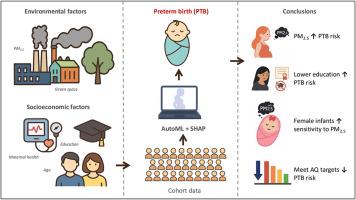使用可解释的机器学习来更好地理解环境和社会经济对早产的贡献
IF 7.3
2区 环境科学与生态学
Q1 ENVIRONMENTAL SCIENCES
引用次数: 0
摘要
早产(PTB)仍然是儿童死亡的主要原因,但环境空气污染的作用仍然存在争议。在中国西南地区(2020-2023)的52,642例单胎分娩队列中,我们将自动机器学习(AutoML)方法与SHapley加性解释(SHAP)相结合,对12种PTB的环境、临床和社会人口学预测因素进行了排名和量化。环境因素共同解释了48.5%的模型特征的重要性,其中住宅环境PM2.5(20.7%),海拔(17.3%)和归一化植被指数(NDVI, 10.5%)成为前三位贡献者。暴露-响应曲线显示,PM2.5阈值超过50 μg/m3时,PTB风险显著增加,平均SHAP值为1.81 (CI: 1.75-1.87)。PM2.5的不良影响在受教育程度低的母亲中被放大(平均SHAP值为1.85,而受教育程度高的母亲为1.78),并因婴儿性别而异,当PM2.5浓度处于最高暴露区(50-80 μg/m3)时,女婴表现出更大的易感性。本研究引入了一个可重复的AutoML-SHAP框架,用于全面量化肺结核风险,并强调严格的空气质量控制,加上有针对性的干预措施,可以大大减少早产。本文章由计算机程序翻译,如有差异,请以英文原文为准。


Using explainable machine learning to better understand the environmental and socioeconomic contributions to preterm birth
Preterm birth (PTB) remains a leading cause of child mortality, yet the role of ambient air pollution remains disputed. In a cohort of 52,642 singleton births in Southwest China (2020–2023), we combined an automated machine-learning (AutoML) method with SHapley Additive exPlanations (SHAP) to rank and quantify 12 environmental, clinical, and sociodemographic predictors of PTB. Environmental factors collectively explained 48.5 % of the importance of the model features, with residential ambient PM2.5 (20.7 %), elevation (17.3 %), and the normalized difference vegetation index (NDVI, 10.5 %) emerging as the top three contributors. The exposure–response curve demonstrated a marked increase in PTB risk above a PM2.5 threshold of 50 μg/m3, with a mean SHAP value of 1.81 (CI: 1.75–1.87). The adverse effects of PM2.5 were amplified among mothers with low educational levels (mean SHAP value 1.85 vs. 1.78 in the high education group) and varied by infant sex, with female infants exhibiting greater susceptibility when PM2.5 concentrations were in the highest exposure bin (50–80 μg/m3). This study introduces a reproducible AutoML–SHAP framework for comprehensive PTB risk quantification and highlights that stringent air-quality control, coupled with targeted interventions, could substantially reduce prematurity.
求助全文
通过发布文献求助,成功后即可免费获取论文全文。
去求助
来源期刊

Environmental Pollution
环境科学-环境科学
CiteScore
16.00
自引率
6.70%
发文量
2082
审稿时长
2.9 months
期刊介绍:
Environmental Pollution is an international peer-reviewed journal that publishes high-quality research papers and review articles covering all aspects of environmental pollution and its impacts on ecosystems and human health.
Subject areas include, but are not limited to:
• Sources and occurrences of pollutants that are clearly defined and measured in environmental compartments, food and food-related items, and human bodies;
• Interlinks between contaminant exposure and biological, ecological, and human health effects, including those of climate change;
• Contaminants of emerging concerns (including but not limited to antibiotic resistant microorganisms or genes, microplastics/nanoplastics, electronic wastes, light, and noise) and/or their biological, ecological, or human health effects;
• Laboratory and field studies on the remediation/mitigation of environmental pollution via new techniques and with clear links to biological, ecological, or human health effects;
• Modeling of pollution processes, patterns, or trends that is of clear environmental and/or human health interest;
• New techniques that measure and examine environmental occurrences, transport, behavior, and effects of pollutants within the environment or the laboratory, provided that they can be clearly used to address problems within regional or global environmental compartments.
 求助内容:
求助内容: 应助结果提醒方式:
应助结果提醒方式:


